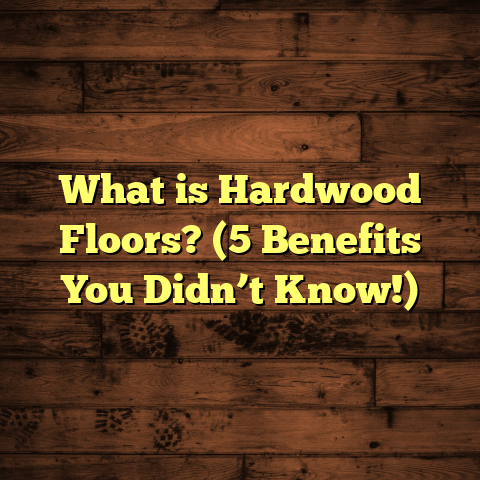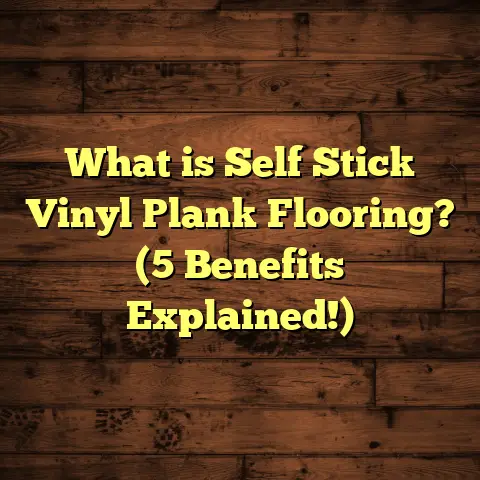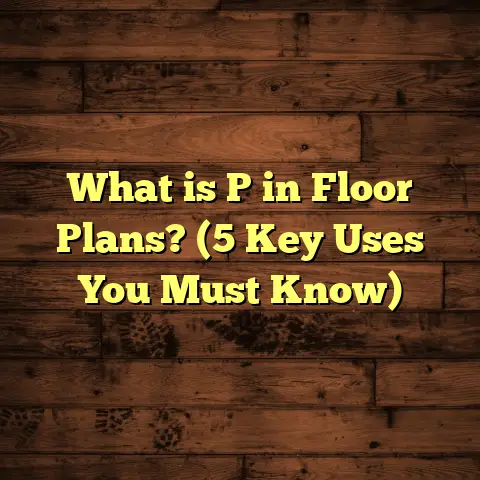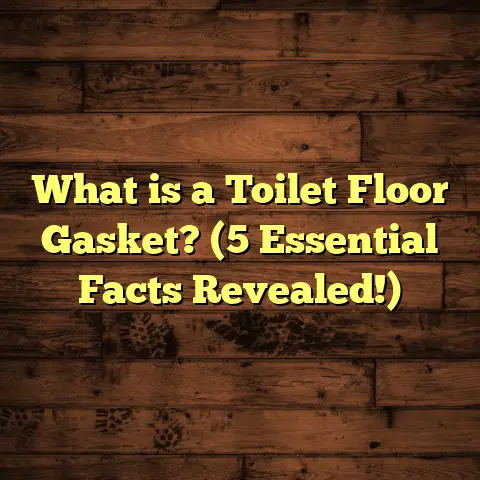What is Vinyl Flooring Called? (5 Types You Need to Know!)
Have you ever looked down at a floor and thought, “What exactly is this made of?” I know I have. Sometimes floors look like real wood or tile but feel completely different underfoot. If you’ve ever been curious about vinyl flooring—what it is, what it’s called, and what your options are—you’re in the right place. I’ve worked with vinyl flooring for years, both installing it and helping clients choose the best fit for their homes. Let me take you through everything I know about vinyl flooring and the five main types that anyone interested should know.
What Is Vinyl Flooring?
Vinyl flooring is a synthetic product primarily made from polyvinyl chloride (PVC). It’s a versatile flooring material that comes in sheets, tiles, or planks and is designed to be durable, water-resistant, and visually appealing. Vinyl can imitate the look of natural materials like hardwood, stone, or ceramic without the cost or upkeep those materials require.
The structure of vinyl flooring usually consists of multiple layers:
- Backing Layer: This provides stability and support to the floor.
- Core Layer: Adds strength and durability.
- Design Layer: A printed layer that gives the visual appearance—wood grain, stone texture, or tile patterns.
- Wear Layer: A transparent protective coating that guards against scratches, stains, and fading.
Vinyl has been around since the 1950s, but it’s come a long way. Modern vinyl floors look incredibly realistic and can last decades when properly installed and maintained.
Why Do People Choose Vinyl Flooring?
You might ask why vinyl has become so popular over other flooring options. Well, here are some reasons I’ve noticed over the years working on many projects:
- Affordability: Vinyl is generally less expensive than hardwood or natural stone.
- Water Resistance: Vinyl handles moisture much better than wood or laminate.
- Durability: With a good wear layer, vinyl resists scratches and dents.
- Design Variety: It comes in endless colors and patterns.
- Ease of Installation: Many vinyl products are DIY-friendly with click-lock mechanisms.
According to industry data from 2023, vinyl flooring made up about 27% of residential floor installations in North America. That’s a huge share! It shows how trusted vinyl has become among homeowners and professionals alike.
1. Sheet Vinyl Flooring
Sheet vinyl is one continuous roll of vinyl material that installers cut to size. It’s especially common in kitchens, bathrooms, laundry rooms—anywhere where a waterproof surface is a must.
How Sheet Vinyl Works
Because it’s one unbroken surface, sheet vinyl offers excellent water resistance with very few seams. This reduces the risk of water seeping through joints and damaging the subfloor beneath.
Sheet vinyl is usually 1/8 to 1/4 inch thick and comes in widths typically around 12 feet. The wear layer thickness varies based on quality; commercial-grade sheet vinyl has thicker wear layers than residential versions.
Cost and Installation
Sheet vinyl is one of the most budget-friendly options for flooring. Installed costs generally range from $2 to $5 per square foot depending on quality and location.
Installation requires skill to cut the sheets precisely and lay them flat without bubbles or wrinkles. Sometimes adhesives are used to bond the sheet to the subfloor; other times it’s loose-laid with tack strips around the edges.
Pros and Cons
Pros:
- Seamless surface ideal for wet areas
- Affordable upfront cost
- Easy to clean and maintain
- Can mimic wood grain or stone patterns
Cons:
- Difficult to repair if damaged
- Can look less “high-end” compared to planks or tiles
- Susceptible to gouges from sharp objects
My Experience with Sheet Vinyl
I once worked on an older home where the laundry room floor had badly water-damaged hardwood planks. The homeowner wanted a waterproof solution that felt warm underfoot but was easy to clean. Sheet vinyl was perfect—after installation, the room looked fresh and bright with no worries about moisture damage returning.
2. Luxury Vinyl Tile (LVT)
Luxury Vinyl Tile (LVT) offers a different approach: instead of one big sheet, it comes in individual tiles designed to resemble ceramic or stone tile.
What Makes LVT Different?
LVT is thicker than sheet vinyl—typically 4 to 8 mm—and often has a rigid core for durability. The tiles can be glued down or floated over an existing floor.
The design layer on LVT is highly detailed, capturing textures and colors of natural stone or porcelain tiles. Many LVT products even have embossing so you can feel the “grout lines” or stone edges underfoot.
Installation Options
LVT installation varies by product:
- Glue-down: Tiles are adhered directly to the subfloor.
- Click-lock floating: Tiles snap together without glue.
- Loose lay: Tiles stay in place by weight or friction.
Each method has its pros and cons regarding installation speed, cost, and future removal possibilities.
Durability and Maintenance
LVT is extremely durable against scratches, stains, and moisture—making it suitable not just for homes but commercial spaces as well.
Regular sweeping and damp mopping keep it clean. Unlike real tile, there’s no grout to seal or maintain.
Pricing
LVT tends to be more expensive than sheet vinyl but cheaper than real stone tile. Installed costs can range from $4 to $8 per square foot depending on quality and installation method.
Why I Suggest LVT for Certain Projects
For clients wanting that upscale tile look without coldness or grout maintenance issues, LVT is an excellent option. It’s great for kitchens, bathrooms, or even basements where moisture could be a problem.
3. Luxury Vinyl Plank (LVP)
Luxury Vinyl Plank (LVP) is similar in concept to LVT but mimics hardwood flooring instead of tile or stone.
What Makes LVP Special?
LVP planks come in lengths ranging from 36 to 72 inches and widths around 6 inches. They feature wood grain textures that replicate oak, maple, hickory, or even exotic woods.
Because it’s vinyl underneath with a textured design layer on top, LVP offers better scratch resistance than hardwood but gives you that warm wood feel many people want.
Installation Methods
Like LVT, LVP can be glued down or installed as a floating click-lock floor. Floating floors provide easier installation and replacement options with minimal mess.
Durability Insights
LVP stands up well to heavy foot traffic, pets, kids, and moisture—a combination that traditional hardwood can’t always handle.
I’ve seen LVP floors last more than 15 years in busy households with little wear visible. The protective wear layer thickness plays a big role here; thicker layers mean longer-lasting floors.
Cost Breakdown
Installed costs usually fall between $3 and $7 per square foot depending on brand quality and labor rates.
My Personal Story with LVP
Years ago I chose LVP for my basement renovation because of humidity concerns that ruled out wood floors. I wanted something realistic looking yet water-resistant. Friends often complimented how natural the floor appeared—even without knowing it was vinyl! And after years of kids running around, it still looks practically new.
4. Sheet Vinyl with Extra Thick Wear Layer
Some sheet vinyl products come with enhanced wear layers designed for heavy-duty use—like commercial spaces or very active homes.
Why Is Wear Layer Thickness Important?
The wear layer protects the printed design beneath from scratches, stains, fading from sun exposure, or general wear over time.
Thickness is measured in mils (thousandths of an inch). Residential sheet vinyl usually has 12-20 mil wear layers; commercial types can go up to 40 mil for extreme durability.
Typical Applications
You’ll find these heavy-duty sheets in hospitals, schools, retail stores—anywhere high foot traffic demands tough surfaces.
In homes with pets or kids who can be rough on floors, this extra protection extends lifespan significantly.
Installation Considerations
Thicker wear layers sometimes mean slight increases in cost but also better long-term value due to less frequent replacement needs.
I’ve installed these sheets in gyms where equipment dragged across floors daily—the owners reported no visible damage after years compared to previous floors needing early replacement.
5. Click-Lock Vinyl Flooring
Click-lock systems are among my favorite types because they make installing vinyl so accessible—even for DIYers.
How Does Click-Lock Work?
Individual planks or tiles have specially designed edges that snap together securely without glue or nails.
This floating floor system allows you to install over many subfloor types like concrete slabs or wood boards without extensive prep work.
Benefits of Click-Lock Flooring
- Quick installation: Rooms can be finished in days rather than weeks.
- Easy repairs: Damaged sections pop out without disrupting entire floors.
- Minimal mess: No glue fumes or drying times.
- Removability: Great for rentals or temporary installations.
Cost Factors
Click-lock vinyl flooring generally costs between $3 and $7 per square foot installed depending on product grade and labor availability.
Comparing Vinyl Flooring Types: What Fits Your Needs?
Choosing between these five types depends mainly on your budget, style preferences, room function, and installation skills. Here’s a quick comparison:
| Type | Water Resistance | Installation Difficulty | Durability | Visual Realism | Cost per Sq Ft Installed |
|---|---|---|---|---|---|
| Sheet Vinyl | Excellent | Moderate | Moderate | Moderate | $2 – $5 |
| Luxury Vinyl Tile (LVT) | Excellent | Moderate | High | High | $4 – $8 |
| Luxury Vinyl Plank (LVP) | Excellent | Easy/Moderate | High | Very High | $3 – $7 |
| Sheet Vinyl w/ Thick Wear Layer | Excellent | Moderate | Very High | Moderate | $3 – $6 |
| Click-Lock Vinyl | Excellent | Easy | High | High | $3 – $7 |
How Vinyl Flooring Holds Up Against Other Popular Floors
When I discuss flooring options with clients, they often ask how vinyl stacks up against hardwood, laminate, tile, or carpet.
Here’s what I usually share:
Hardwood vs Vinyl
Hardwood floors have natural beauty unmatched by other materials but are pricey ($8-$15/sq ft) and vulnerable to water damage and scratches. Vinyl offers similar aesthetics at lower cost with far better moisture resistance and simpler upkeep.
Laminate vs Vinyl
Laminate imitates wood but doesn’t handle water well; it can swell if exposed to moisture. Vinyl beats laminate on durability and water resistance while sometimes offering better design realism due to embossing techniques.
Tile vs Vinyl
Ceramic or porcelain tile lasts forever but feels cold underfoot and requires grout maintenance. Luxury vinyl tiles look like ceramic but provide softer warmth plus easier cleaning at half the cost in many cases.
Carpet vs Vinyl
Carpet adds softness but stains easily and wears quickly in high traffic areas. Vinyl tolerates spills better and lasts longer while being easier to maintain.
Installation Tips I’ve Learned Over Time
If you’re thinking of installing vinyl flooring yourself or hiring someone else, here are some practical pointers based on my years of experience:
- Always prepare your subfloor thoroughly—clean it well and fix any cracks or uneven spots.
- Acclimate your vinyl planks/tiles before installation by letting them sit in the room for 48 hours.
- Use recommended adhesives if needed; some vinyl products require specific glue brands.
- Measure twice before cutting—cutting errors waste material quickly.
- Leave expansion gaps around edges if installing floating click-lock systems.
- Consider underlayment for sound dampening if installing over concrete slabs.
Caring for Your Vinyl Floors: What I Tell My Clients
Vinyl flooring is pretty low maintenance compared to other options but still benefits from some care:
- Sweep regularly to avoid grit scratching the surface.
- Use a damp mop with mild detergent—avoid abrasive cleaners or waxes.
- Wipe up spills promptly to prevent stains.
- Use furniture pads under legs to reduce dents.
- Avoid dragging heavy items across floors—lift instead.
Following these simple steps helps preserve your floor’s look for years longer.
Real-Life Case Studies From My Projects
Case Study 1: Kitchen Remodel Using LVP
A client wanted a wood-look floor in their kitchen that could survive spills from cooking and kids’ messes. We recommended luxury vinyl plank with a 20-mil wear layer for durability. Installation took three days with click-lock planks floated over existing tile.
Result: The client loved how warm the floor felt compared to old ceramic tile but appreciated easy cleanup after spills—a perfect balance for their lifestyle.
Case Study 2: Commercial Retail Store Using Sheet Vinyl with Thick Wear Layer
A busy retail store needed new floors that looked professional but would withstand thousands of customers daily. We installed commercial-grade sheet vinyl with a 40-mil wear layer glued down for maximum durability.
Result: After two years there was minimal visible wear despite heavy foot traffic—a testament to selecting the right product for the environment.
Cost Considerations: How Tools Like FloorTally Help Me Plan Projects
Budgeting flooring installations can be tricky—material costs fluctuate by region; labor rates vary; waste percentages depend on layout complexity.
That’s why I use FloorTally for quick cost estimates during project planning phases. This tool lets me input local material prices, labor costs, square footage dimensions, waste factors based on installation types (like sheet versus plank), plus other variables like underlayment needs.
It saves me hours by consolidating calculations into one platform instead of juggling spreadsheets or calling multiple suppliers for quotes. It also helps me visualize how switching from sheet vinyl to luxury planks affects overall budgets immediately—making client conversations smoother when discussing options versus costs.
For example: On a recent home project covering roughly 1,200 square feet with luxury vinyl plank flooring plus underlayment and installation labor included, FloorTally helped me estimate total project cost around $7,500 including waste factor adjustments—which was within budget expectations before ordering materials.
Wrapping Up Thoughts on Vinyl Flooring Names & Types
So what exactly is vinyl flooring called? It depends on which type you mean:
- Sheet Vinyl: Continuous rolls ideal for wet areas.
- Luxury Vinyl Tile (LVT): Tile-shaped pieces mimicking stone/ceramic.
- Luxury Vinyl Plank (LVP): Planks replicating hardwood looks.
- Sheet Vinyl with Thick Wear Layer: Heavy-duty commercial/residential sheets.
- Click-Lock Vinyl Flooring: Easy-install floating planks or tiles snapping together without glue or nails.
Each type fits different needs based on style preference, budget, room use, and installation skill level. Over my years working closely with these materials—installing them myself and advising clients—I’ve learned that vinyl delivers tremendous versatility rarely matched by other flooring options.
If you’re still unsure which type suits your space best or want help estimating costs realistically using tools like FloorTally, feel free to ask! I’m here to help guide you toward a beautiful floor you’ll love walking on every day.
Would you like me to expand more on any specific type? Or maybe add detailed installation step-by-step guides? Just let me know!





